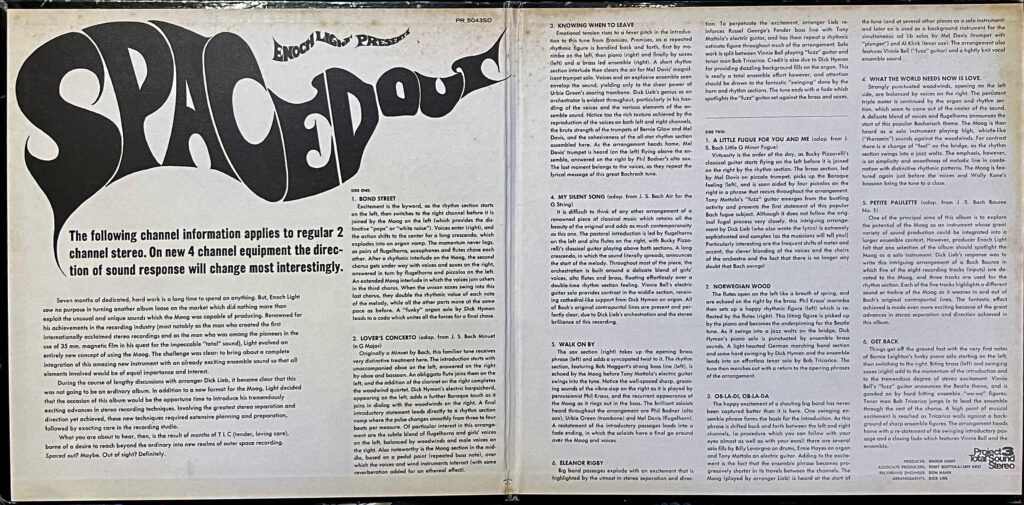Welcome to another sonic deep dive on Finnley’s Audio Adventures! I’m your host, Finnley the Dolphin, and today we’re exploring the remarkable world of Enoch Light, a true maestro of sound and a visionary in music production. Light’s career, spanning over four decades, showcases a brilliant fusion of innovation and artistry that has left an indelible mark on the audio landscape. From his early days orchestrating the dance rhythms of his orchestra to his groundbreaking experiments in stereo and quadraphonic sound, Light’s journey is not just about music; it’s about experiencing sound in a completely new way. So, let’s strap in and tune our senses to the vibrant and visionary world of Enoch Light!
Enoch Light: A Maestro of Sound and Visionary in Music Production
Enoch Light’s career, spanning four rich decades, is a testament to the power of innovative thinking in the world of music production. From his early days in the 1930s, when he led a dance orchestra, to his pioneering ventures in stereo and quadraphonic sound recordings, Light’s influence remains profoundly felt in the audio landscape.
Born in Canton, Ohio, Light was not only a capable violinist but also a visionary with a keen interest in enhancing how music was recorded and presented. After graduating from high school as a valedictorian, he furthered his studies at Johns Hopkins University and the Institute of Musical Art, now known as the Juilliard School. His formal education laid a sturdy foundation, but it was his relentless innovation that defined his career.
In the 1930s, Light moved to New York to try his hand at the big band scene. He formed the Enoch Light Orchestra, which enjoyed success in the prestigious venues like the Taft Hotel in New York. However, it was in the late 1950s and 1960s that Light truly revolutionized music production. He delved into stereo recording, a novelty at the time, ensuring that his recordings weren’t just heard but experienced in a multi-dimensional soundscape.
His label, Command Records, became a laboratory for auditory experiments. Albums like “Persuasive Percussion” and “Provocative Percussion” were not just collections of songs but sonic adventures that showcased what stereo sound could achieve. These records were marked not only by their musicality but by their strikingly designed gatefold covers, which became collectors’ items.
Light was ahead of his time in recognizing the importance of cover design in marketing music, and he used abstract and vibrant art to draw listeners into the immersive experiences his albums promised. This attention to detail extended to his meticulous oversight of recording sessions, often using 35mm film instead of traditional tape to capture a broader range of sounds.
But Light’s innovation wasn’t confined to just techniques and technologies. He was deeply committed to the clarity and fidelity of the sound. His recordings were crisp, clear, and ahead of their time, making full use of the stereo format to enhance the listener’s experience. This quality was so revered that it set a new standard in the industry.
In the early 1960s, Light introduced groundbreaking recording techniques that revolutionized the audio quality of music. Utilizing 35mm film instead of the conventional tape, his recordings captured a broader range of sounds with stunning clarity and depth. This method not only enhanced the audio fidelity but also allowed for a more dynamic presentation of music, emphasizing stereo effects that were innovative at the time.
Light’s dedication to high-quality sound was evident in his meticulous approach to record production. He believed that the listener’s experience should be as immersive and pure as possible, which led him to focus extensively on the engineering aspects of recording. His albums, particularly those like “Persuasive Percussion” and “Provocative Percussion,” showcased this commitment to quality, featuring complex arrangements that were optimally recorded to exploit the new stereo capabilities.
His innovative spirit was not confined to technical advancements; Light was also ahead of his time in terms of marketing and production. He understood the importance of packaging and presentation, which was reflected in his detailed attention to album cover designs. These covers were not only visually appealing but also designed to complement the high-quality sound within, making his albums coveted items among audiophiles.
Light’s insistence on high fidelity and his pioneering use of stereo sound laid a foundation that many modern recording practices are built upon. Despite the costs associated with his advanced recording techniques, he maintained a philosophy that prioritizing the quality of sound over mass production was key to genuine success in the music industry. He famously remarked that when selling an album for $5.98, the focus should be on delivering an unparalleled auditory experience, not just on moving large quantities.
Enoch Light and His Entrepreneurial Ventures in the Music Industry
Enoch Light, known for his innovative approach in the music production scene, also left a significant imprint in the business world through his establishment of various labels and companies. His entrepreneurial spirit was evident in his strategic partnerships and keen business acumen, which furthered his vision of high-quality sound production.
In August 1966, Enoch Light expanded his influence in the music industry by forming Project 3 Records in partnership with The Singer Company. This label was part of a broader initiative known as Project 3 Total Sound, embodying Light’s commitment to producing recordings that showcased the full spectrum of stereo sound technology. Project 3 Records was known for its high fidelity recordings, contributing significantly to the audiophile movement of the time.
Adjacent to the label, The Total Sound Inc., also led by Light as president, functioned as a manufacturing company. Together with Tony Mottola and Jeff Hest, who served as A&R producers, this company managed production and artistic decisions, ensuring that each release met Light’s stringent quality standards. The Total Sound Inc. operated under the parent label MCA Inc., further establishing its presence in the industry with sublabels like Project 3 and Project 3 Records.
The Singer Company, Light’s partner in Project 3 Records, was historically known for its innovations in the manufacturing of sewing machines. Founded in 1851 by Isaac Merritt Singer and New York lawyer Edward Clark, the company underwent several transformations, renaming itself as The Singer Manufacturing Company in 1865 and later as The Singer Company in 1963. Although primarily recognized for its sewing machines, through its association with Light and the music industry, The Singer Company expanded its reach into audio production and education-related products.
Spaced Out: The Retro-Futuristic Sounds of Enoch Light and The Light Brigade

In the psychedelic haze of 1969, Enoch Light and The Light Brigade released an album that was both a product of its time and a harbinger of sounds yet to come. Titled “Spaced Out”, this album was pressed under the Project 3 Total Sound label and showcased an audacious blend of genres that captured the spirit of the era while peering curiously into the future.
The album, presented in a visually striking gatefold cover, was issued in both stereo and quadraphonic formats. This Quadraphonic 4 Channel Stereo capability was particularly groundbreaking, offering an immersive listening experience that was quite avant-garde for its time. Listeners equipped with the appropriate audio setups could enjoy a soundscape that enveloped them, with sounds coming from four different corners of the listening space. This innovative audio technology enhanced the album’s futuristic appeal, making each track not just music to the ears but an enveloping auditory spectacle.
“Spaced Out” traverses the musical landscapes of Electronic, Jazz, and Pop, but it is perhaps most notable for its distinctive leanings towards Space-Age, Big Band, Novelty, and Synth-pop styles. This eclectic mix not only defined a new aesthetic but also underscored the adventurous production choices of Enoch Light.

The album kicks off with “Bond Street,” a composition by Burt Bacharach, setting the tone with its upbeat tempo and sophisticated orchestration. What follows is a series of auditory delights, including “Lover’s Concerto” and “Knowing When to Leave,” both penned by Bacharach and Hal David, showcasing the album’s knack for blending classical influences with contemporary pop.
A fascinating aspect of “Spaced Out” is its reinterpretation of classical motifs, with several tracks adapted from Johann Sebastian Bach’s compositions. “My Silent Song” and “A Little Fugue For Me And You” are prime examples, offering a Baroque twist to the modern soundscape. Meanwhile, tracks like “Eleanor Rigby” and “Norwegian Wood” by The Beatles are reimagined through Light’s innovative lens, bringing a fresh perspective to these familiar tunes.
The album also ventures into playful territory with tracks like “Ob-la-di, Ob-la-da,” and then dips into the reflective with “What The World Needs Now Is Love.” Each track is meticulously crafted, ensuring that “Spaced Out” is not just heard, but experienced.

As we bring our exploration of Enoch Light to a close, it’s clear that his innovative spirit and dedication to sonic excellence continue to resonate in the world of music production. Light wasn’t just ahead of his time; he helped define that time for future generations. From “Persuasive Percussion” to “Spaced Out,” his works invite us to not just listen, but to experience music in a multi-dimensional soundscape. Thank you for joining me, Finnley the Dolphin, on this auditory adventure through the life and legacy of Enoch Light. Remember, the world of sound is vast and full of wonders—keep exploring, and keep listening. Until next time, dive deep and let the music carry you away on Finnley’s Audio Adventures!
Sources:
Billboard Articles
- “Sound and Light. The Story of Enoch Light and Project 3.” Billboard, 18 Feb. 1967, pp. 65-66, 80.
- Gross, Mike. “Kusisto, Munves, Usher See Quad-8 as Sound Wonderland.” Billboard, 14 Nov. 1970, pp. 1, 20.
- “Bandleader Enoch Light Dies in N.Y.” Billboard, 12 Aug. 1978, p. 6.
Discogs Entries
- “The Total Sound Inc.” Discogs. Accessed 20 July 2024. https://www.discogs.com/label/363084-The-Total-Sound-Inc?page=1.
- “Project 3 Records.” Discogs. Accessed 20 July 2024. https://www.discogs.com/label/65317-Project-3-Records.
- “Essex Entertainment Inc.” Discogs. Accessed 20 July 2024. https://www.discogs.com/label/54749-Essex-Entertainment-Inc.
- “Singer.” Discogs. Accessed 20 July 2024. https://www.discogs.com/label/209471-Singer.
- “Enoch Light Presents Spaced Out.” Discogs. Accessed 20 July 2024. https://www.discogs.com/release/5922866-Enoch-Light-Presents-Spaced-Out.
